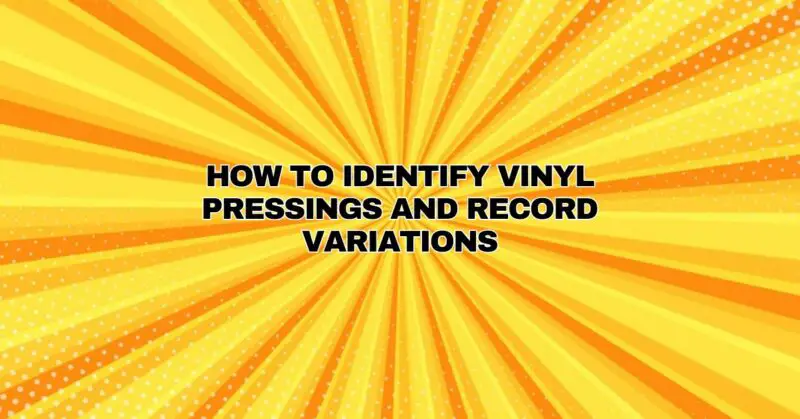Vinyl records have made a remarkable comeback in recent years, attracting both audiophiles and collectors. Within the world of vinyl, understanding how to identify different pressings and variations of your favorite records is a valuable skill. These distinctions can affect sound quality, rarity, and value. In this comprehensive guide, we’ll explore the art of identifying vinyl pressings and record variations.
1. Start with the Basics: Understanding Vinyl Pressings
Before diving into the nuances of identifying pressings and variations, it’s crucial to grasp the fundamentals. A vinyl pressing refers to a batch of records produced at the same time from a single set of stampers. These stampers are used to press grooves into vinyl discs, creating playable records. Here are some essential concepts:
- First Pressing: The initial batch of records produced from the first set of stampers is known as the first pressing. These are often considered the most valuable and collectible.
- Reissues: As an album gains popularity or goes out of print, record labels may produce subsequent pressings, known as reissues. Reissues can have different characteristics from the original pressing.
- Label Variations: Different pressings can feature variations in label design, typography, and color. These label details can be important for identification.
- Matrix Numbers: Matrix or runout numbers are etched into the runout groove of the vinyl. They often contain codes that can reveal information about the pressing, such as the mastering engineer, pressing plant, and version.
2. Use Online Resources:
The internet is a valuable tool for vinyl collectors. There are several online resources and databases dedicated to cataloging vinyl releases. Discogs, for example, is a popular platform where users contribute information about vinyl releases, including details about different pressings and variations. You can search for a specific album or artist to find information about its various releases.
3. Examine the Cover and Sleeve:
Album covers and sleeves can provide important clues about the pressing. Here’s what to look for:
- Catalog Numbers: Check the catalog number on the cover and spine. Catalog numbers may change with different pressings or reissues.
- Barcodes: The presence or absence of barcodes on the cover can indicate the era of the pressing. Barcodes became more common in the late 1970s and early 1980s.
- Typography and Design: Pay attention to the typography, design, and layout of the cover. Changes in these elements can suggest different pressings.
- Print Quality: Examine the overall print quality of the cover. Early pressings may have different printing techniques and paper quality.
4. Inspect the Vinyl Record:
The physical characteristics of the vinyl record itself can provide clues about the pressing:
- Label Design: Different pressings often feature variations in label design, color, and logos. Compare the labels on your record with known images of first pressings.
- Vinyl Color and Weight: Early records were typically black, but colored vinyl or heavier-weight vinyl (e.g., 180 grams) became more common in later pressings.
- Matrix Numbers: Examine the matrix numbers etched into the vinyl’s runout groove. These numbers can be used to identify the pressing.
5. Research Release History:
To identify variations accurately, research the release history of the album. Check for information about different pressings, reissues, and variations in collector forums, vinyl collector books, and online music databases.
6. Seek Expert Advice:
If you’re uncertain about the identification of your vinyl record, consider seeking advice from experienced collectors, record store owners, or vinyl enthusiast communities. They can often provide valuable insights and help you make an accurate determination.
7. Join Vinyl Collector Communities:
Engaging with vinyl collector communities can be immensely helpful. Websites, forums, and social media groups dedicated to vinyl collecting are excellent places to seek guidance, share your finds, and learn from experienced collectors.
8. Attend Record Fairs and Shows:
Record fairs and shows are great opportunities to meet fellow collectors, browse vinyl selections, and learn more about identifying different pressings and variations. You can also find rare and unique records at these events.
Conclusion: The Art of Vinyl Identification
Identifying vinyl pressings and record variations is a skill that develops over time through experience and research. Whether you’re a seasoned collector or just starting your vinyl journey, the thrill of discovering unique pressings and variations adds depth and excitement to the world of vinyl records. Remember that collecting vinyl is not solely about value; it’s about appreciating the history, craftsmanship, and sonic qualities that each pressing and variation brings to your collection. So, embrace the hunt, expand your knowledge, and enjoy the treasure trove of vinyl records at your fingertips.


